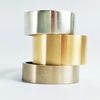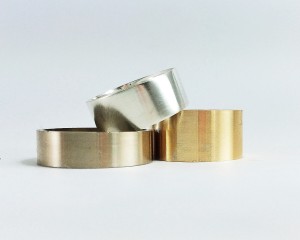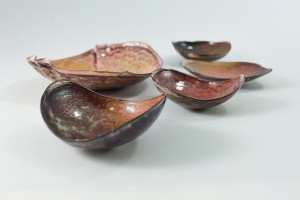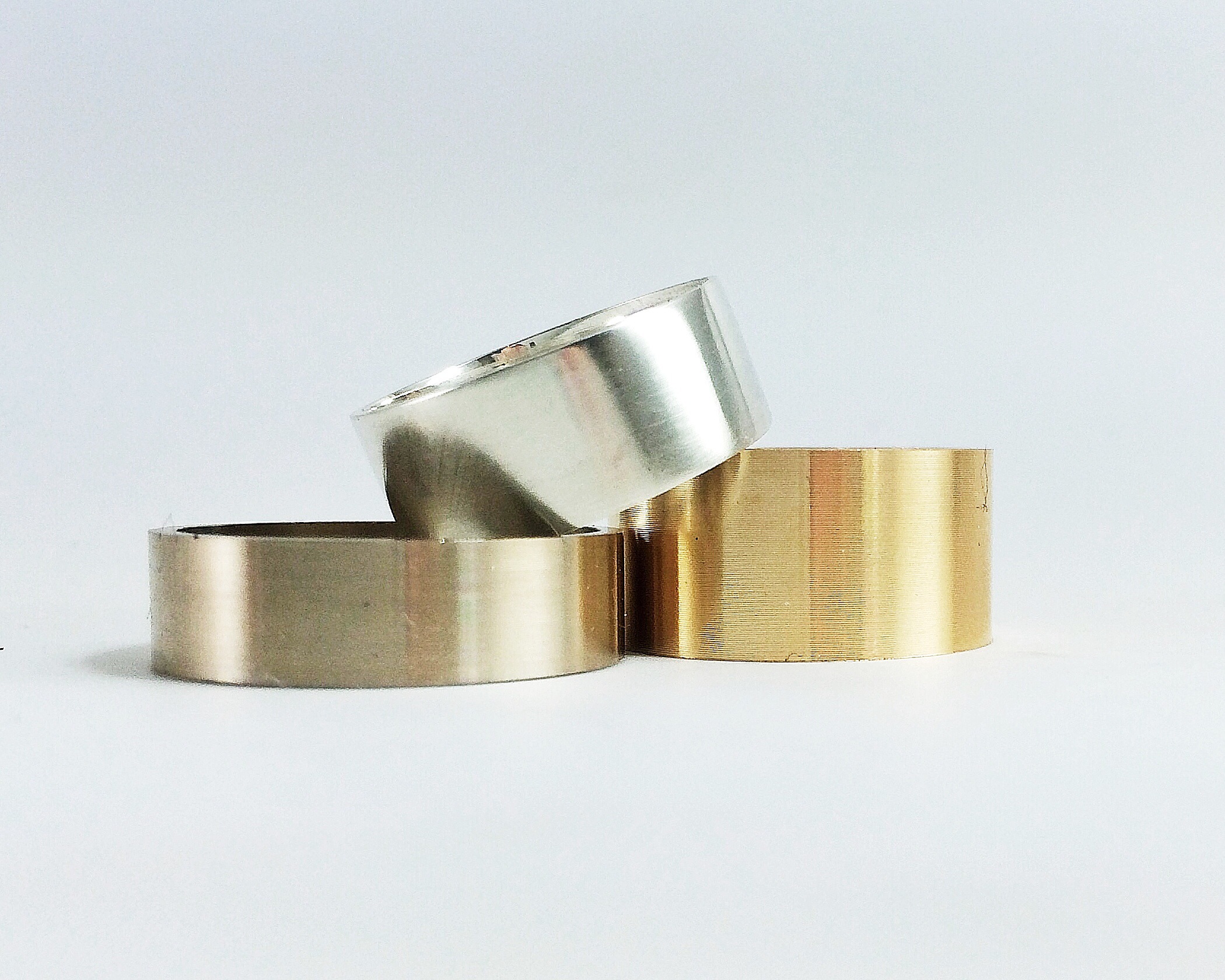26 Mar My Metals Manifesto
As a metalsmith, I could talk metals all day.
I work mostly with non-ferrous and precious metals, including gold, white gold, platinum, palladium, copper, silver, brass and bronze. I am often asked which metal I prefer and why, or what metal is best for various uses. Here’s my abridged manifesto on my favorite metals:
STERLING SILVER
Silver was my first love, and it is still my daily friend. It’s malleability and softness make it less than ideal for daily lifelong wear. But, that aspect aside, it is a wonderful choice for its affordability, patination possibilities, and versatility in fabrication, casting and forging.

Ginger’s top three metals – sterling silver, yellow gold, palladium white gold.
There are a variety of options in the silver family from 99.9% pure fine silver to Argentium Silver (alloy of silver and germanium), and others. I stand by sterling, though, which is 92.5% silver and 7.5% copper. It tempers well, patinas beautifully (which is a plus for my narrative aesthetic), and is generally a pleasure to work. It also conducts heat really well, which is a drawback for repair, alteration or restoration work. But I enjoy the challenge of sterling silver repair work. It keeps things interesting!
PALLADIUM WHITE GOLD
White gold alloys are a broad category. I’ll explain, but first I have a story…
In the early 1990s when my then fiancé and I were approaching our wedding day, I wasn’t yet a goldsmith. So, we had our rings made by a local metalsmith.
Since it was the early 1990s, my ring was a mixed metal piece using yellow, rose and white golds. It was a beautiful piece, and for about a year I wore it with no problem. Then, my hand started to itch. The skin under and around my ring turned red, flaky, and later raw and bloody. I was allergic to my wedding ring. I now know that I developed an allergy to the nickel content in the white gold alloy. Nickel allergies are becoming more common, particularly after repeated wear/contact, as in my case. Unfortunately, nickel is a standard component in most white gold alloys made in the United States. Some American-made white gold alloys are as much as 17% nickel, which is a cheap and easy white metal.

Ginger’s favorite metals for jewelry: (L-R) palladium white gold, sterling silver, yellow gold
Gold is, of course, naturally a yellow metal. It is alloyed with other metals for strength, durability, and color preference. A white metal is alloyed with yellow gold to make it white for jewelry use. Palladium (in the platinum family of metals) is the standard white metal component for white gold alloys in Europe. I work frequently with palladium white gold in both 14 karat and 18 karat, and it is on my short list of (three) favorite metals. Palladium white gold is extremely durable, and it’s a beautiful warm white metal color.
(By the way, I ditched that ring with the nickel, and kept the husband.)
YELLOW GOLD
The warmth and old-world feel of yellow gold is unmatched. Aesthetically I prefer it in small amounts for some reason, as an accent on a mixed metal piece, or in smaller scale designs. It is a delight to forge and fabricate, and there really is no substitute for its warmth and sense of value and comfort.
In our culture, yellow gold brings about a sense of tradition and value, and the global history of the use of yellow gold in jewelry of all kinds certainly supports that. There is something familiar and warm about a yellow gold ring or pendant. I have worked with gold in all karat values, but I prefer 18 karat.
In my renaissance jewelry work (transforming a client’s existing piece of jewelry into something new), I often melt down yellow gold pieces, pour ingots and form them into sheet or wire that I use to build something else. I adore the way yellow gold remains “stable” in all the phases of the process of metalsmithing – from fire to forge. It’s a pretty happy metal with few technical surprises as long as the metalsmith respects its limits.
COPPER
If yellow metals are warm, then red metals are hot. The color is so very warm and beautiful, and the wonderful variety possible in patination could become an art language all on its own. I use copper for enameling, for working out technical challenges (making samples), and as an accent metal with sterling silver.

Receiving Bowls by Ginger Meek Allen – transparent enamel on copper vessels
Copper is often my starting point for an enameling project. I tend to take a non-traditional approach to enameling in that I like to allow the copper oxides to affect the colors in transparent enamels. The unpredictability of that process excites me. I like the fact that I can’t control those colors that emerge when I fire a copper vessel covered in transparent enamel, doing nothing to contain those copper oxides. (I’m such a rebel sometimes.)

Using Copper as a Narrative Accent (Amber Journey Bracelet)
When it comes to jewelry, I love to use copper to tell a story and to bring warmth without extensive material expense. With the exception of the occasional request from a golfer for a cuff bracelet when he wants the orthopedic benefit of the copper oxides in his system, I tend to use copper in finished jewelry in a way that minimizes the skin contact because of the way it will cause a skin reaction in most folks. I do like to use it as an accent in an area where I’m creating a narrative composition.
PLATINUM
Known for its durability, platinum is a choice often rooted in high value and longevity. The perceptions of platinum that I hear from my clients is always interesting, as many have been told that platinum is “the most durable” choice, and is “always the most expensive” choice. There is some truth in both of those notions, but not for the reasons you would think. Platinum is a deep color, and tends to not hold a polish as well as gold alloys. It’s tendency to be expensive is often just as much because of the particular technical processes it requires in the studio as much as it is about its market price that day. In recent years I have seen the gold market exceed the platinum market at times, but because of the milling costs, etc., platinum is still more expensive for me to buy as raw metal stock.
For those clients looking for purity and durability, platinum is a great choice. There is also something sophisticated about platinum pieces – a sense of elevation and solidity.
ROSE GOLD
I reach for rose gold when I want warmth, quality and longevity. It presents some technical challenges in forging and fabricating, but as with yellow gold, it performs well as long as I understand its limits. I choose to use it in fine art jewelry when I want the durability and high value of gold, and a more non-traditional approach to a warm aesthetic.
***
So, if you are still with me here, that’s incredible! This may be way more information that most people really need or want, but, like I said, it’s one of my favorite topics. Would you believe I’m actually holding back?!!?
🙂
Thanks for reading.








Corinne
Posted at 17:33h, 26 MarchI think I’m the first comment. I have a nickel allergy too, but had no idea that white gold had a high nickel content. Still wearing the first wedding band, yellow gold. I’ve always been tempted to have my Mom’s diamond reset in white gold. I won’t thanks to this information. (Uplevel Gold)
Ginger Meek Allen
Posted at 17:39h, 26 MarchHi, Corinne! Nickel allergies are so much more common these days. You can indeed reset your mom’s diamond in white gold as long as it’s a nickel-free alloy like palladium white gold. I do things like that for my clients all the time.
And, thanks for being the first to comment!
#uplevel